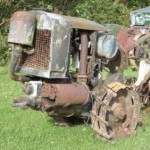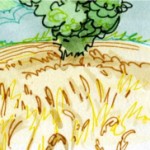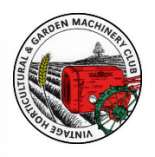Home › Forums › The Machinery Forums › Garden implements › MYSTERY FORK
Tagged: MYSTERY FORK
- This topic has 7 replies, 6 voices, and was last updated 10 years, 10 months ago by
 charlie.
charlie.
-
AuthorPosts
-
February 4, 2015 at 8:32 pm #11588
stevewoollas
ParticipantWe saw this fork recently and had not seen one like it before so temptation got the upper hand and we bought it. The handle has been shortened and presumably the original was a long straight shaft or a shaft with a D or T shaped end. The tines are perfectly flat, 9″ long and 9″ wide overall. Each tine is machined to a point. The two oval rings are cold riveted in place and the flat top of the oval lines up with the top of the tines as if to push ones foot against.
Our questions are:
Has anyone seen one of these before?
Does anyone know what it is for?
Who may have produced it?
How old may it be?February 5, 2015 at 10:40 am #11595 charlieKeymaster
charlieKeymasterOne observation, it does not appear to be intended for heavy work. The metal between handle and body of fork seems rather light. Could the two loops be used as a leverage point?
February 5, 2015 at 2:00 pm #11599 daveParticipant
daveParticipantMy old Dad had a fork much like that one minus the two riveted rings
but with the flat tines. He always called it his potatoe fork and
would always use it when digging up the spuds in the garden.
I hope that this may help. Dave.February 9, 2015 at 5:21 am #11633 vhgmcbuddyMember
vhgmcbuddyMemberthe rings appear to be on wrong side for leverage, could it possibly been dragged through soil like a tiller and the tines used as
February 15, 2015 at 10:32 pm #11700 trustymasseymanParticipant
trustymasseymanParticipantSteve I have a feeling this may well well of been used by poachers fishing for eels
February 17, 2015 at 11:44 am #11721 pete0250Participant
pete0250Participantpossible that the rings were to protect the soles of the feet. The blade looks quite thin
February 17, 2015 at 2:15 pm #11722stevewoollas
ParticipantThanks for the responses all.
I don’t think it is designed as a potato fork as the tines are too close together and soil would not readily fall between them.
The flat tops to the “O” rings definately lend themselves to have a foot pressed upon them. They are also suitable for prying or levering.
The tines are very close together as those of an eel gleave but without barbs on the end the elvas could wiggle off and escape.
In our view the fork is definitely manufactured for a specific purpose.
Any more ideas??February 18, 2015 at 7:57 am #11743 charlieKeymaster
charlieKeymasterSteve, might be worth contacting Tool and Trades History Society
-
AuthorPosts
- You must be logged in to reply to this topic.





